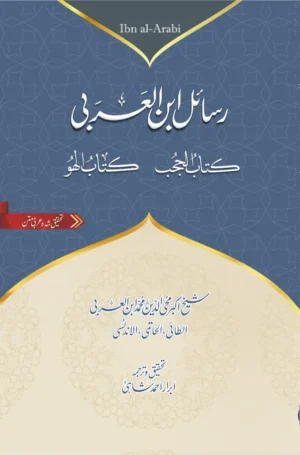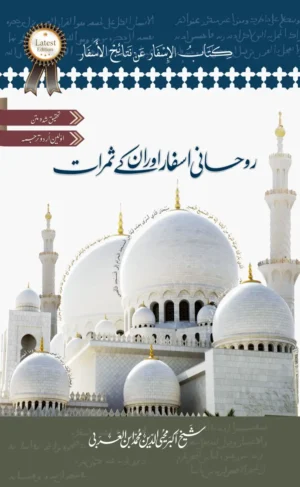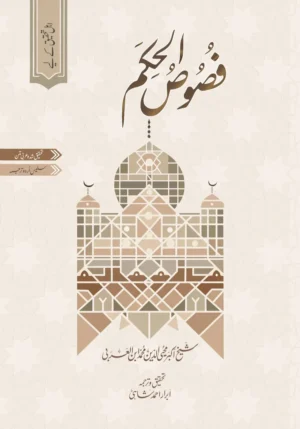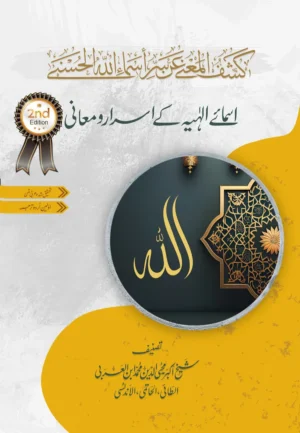Kitāb al-ḥurūf al-thalāthah (Mīm Wāw Nūn)
Author: Shaykh al-Akbar Muhyiddin Ibn al-Arabi
Editor: Abrar Ahmed Shahī
Pages: 43
ISBN: 9789699305207
Dimensions: 255 × 165 mm
Edition: 2021
Shaykh al-Akbar
Ibn al-Arabi
Ibn al-Arabi Foundation
Critical Arabic Edition
PDF – Book
The manuscript available in the Bayezid Library in Istanbul is a handwritten copy by Shaykh al-Akbar Muḥyiddīn Muḥammad ibn al-ʿArabī. It contains two certifications: one from 619 AH in Aleppo and the other from 633 AH in Damascus. The Damascus certification indicates that more than 15 people attended, including all of Shaykh al-Akbar’s close companions, such as his sons Abū Saʿd Muḥammad and Abū al-Maʿālī Muḥammad. It also mentions the notable hadith scholar al-Ḥāfiẓ Abū ʿAbdullāh Muḥammad ibn Yūsuf al-Barzalī al-Ishbīlī (d. 636 AH), who completed the book in two sessions. Shaykh al-Akbar’s handwriting is clear and in the Western script style, where the dot for “fāʾ” is below and the “qāf” has one dot above, instead of two.
This manuscript is part of a collection that includes eight of Shaykh al-Akbar’s books and treatises. The entire collection is written by his hand, dating from 603 AH to 633 AH. The collection includes the following works: _Kitāb al-Sabʿa wa huwa Kitāb al-Shaʾn, Kitāb al-Ḥurūf al-Thalātha allatī Inʿaṭafat Āwākhiruhā ʿalā Awāʾilihā, Kitāb Maqām al-Qurba, Kitāb al-Tajalliyāt, Kitāb al-Jawāb al-Mustaqīm ʿammā Saʾala ʿanhu al-Tirmidhī al-Ḥakīm, Kitāb Manzil al-Manāzil al-Fahwāniyya, Tāj al-Rasāʾil wa Minhāj al-Wasāʾil,_ and _Kitāb al-ʿAẓama_.
The manuscript held in the Sulaymāniyya Library in Istanbul holds historical significance as it was the personal copy of Shaykh al-Akbar’s companion Ayyūb ibn Badr ibn Manṣūr al-Muqriʾ, who read it before Shaykh al-Akbar in 621 AH. The cover page contains a certification with names of several of Shaykh’s companions and servants, including Shaykh Abū Isḥāq Ibrāhīm ibn Muḥammad ibn Aḥmad al-Qurṭubī and Shaykh’s son, Maʿīn al-Dīn Abū Isḥāq Ibrāhīm. Upon close examination, it was found that this manuscript is a copy of the book’s first edition. The additions and omissions made by Shaykh al-Akbar in the second edition, known as Walī al-Dīn – 1759, are absent here.
Written with black ink, the titles are prominent and bold, with comparison and correction marks evident in the margins. This makes it an excellent copy of the book’s first edition. The manuscript’s end reads: “Copied by Ayyūb ibn Badr on the 26th of Ramaḍān, 621 AH, in the presence of the author while he was in retreat at the mosque in Damascus in the room of Abū Ḥāmid al-Ghazālī.”
This manuscript is part of a valuable collection that includes more than eight of Shaykh al-Akbar’s books and treatises. The collection includes the following works: _Kitāb Nuskhat al-Ḥaqq, Mafātīḥ al-Ghayb, al-Madkhal ilā Maʿrifat al-Asmāʾ, Kitāb al-Mīm wal-Wāw wal-Nūn, Risālat al-Ittiḥād al-Kūnī, Kitāb al-Alif wa huwa Kitāb al-Aḥadiyya, Kitāb al-Ḥaqq,_ and _Kitāb al-Shawāhid._
Written in Naskh script by the scribe Jamāl al-Dīn ʿAbdullāh ibn Ibrāhīm for his brother and friend, the ascetic scholar al-Zāhid Quṭb al-Dīn Shaykh Muḥammad ibn Taqī al-Dīn. The manuscript’s date is written in code, reading as Ramaḍān “M.H.ʿ.D.” The scribe’s handwriting is not excellent, but the large letters make it somewhat easier to read. Unfortunately, the manuscript wasn’t protected from water and the pages are quite dark due to poor scanning, making the text difficult to read. Internal evidence indicates that this manuscript is copied from Shahīd ʿAlī – 2831 as both provide the same text of the book’s first edition with no significant differences. The manuscript’s end reads: “Copied from the original that was read before the author and corrected under his supervision.”
This manuscript includes the following works by Shaykh al-Akbar: _Taqsīm Nuʿūt al-Ilāhī, Nuskhat al-Ḥaqq, al-Mīm wal-Wāw wal-Nūn, Kitāb al-Alif wa huwa Kitāb al-Aḥadiyya, al-Ittiḥād al-Kūnī,_ and _Kitāb al-Shawāhid._ The order is similar to that of Shahīd ʿAlī – 2831.
Another manuscript in the Bayezid Library in Istanbul, known for its accuracy, is part of a collection containing over thirty of Shaykh al-Akbar’s books and treatises. This complete collection was copied in 782 AH from the collection of Shaykh Muḥammad al-Zāhidī. Seven of the treatises in this collection are noted to have been copied from Shaykh al-Akbar’s own handwritten copies.
The collection begins with the treatise _Mīm Wāw Nūn._ Written in black ink, the margins show comparison marks. The text is very close to the original Walī al-Dīn manuscript, indicating it is a copy of the second edition. The manuscript’s end reads: “Compared with the original manuscript written by Shaykh Muḥammad al-Zāhidī, who mentioned that he compared it with the author’s copy.”
Written in red and black ink, this manuscript of the treatise Mīm Wāw Nūn is of great importance. It is part of a collection that combines 19 books and treatises by Shaykh al-Akbar, copied by the scribe ʿAbd al-Ṣamad ibn Yaḥyā al-Ṣāliḥī al-Ḥanafī in 910 AH. According to the research of ʿUthmān Yaḥyā, it was copied in Damascus, but this claim has not been confirmed. The collection’s four manuscripts bear certifications indicating that they were copied from the collection written by ʿAbd al-Fattāḥ al-Bazzār, who read them before Shaykh al-Akbar in 627-628 AH. In general, this is a very neatly written and organized collection, although in its current state, it is not in its original condition.
Upon careful examination, this manuscript was found to be close to Walī al-Dīn – 1759, the manuscript written by Shaykh al-Akbar himself, making it a reliable copy. The end of the manuscript reads: “Completed the transcription of this blessed copy on the blessed Saturday, the third of the month of Ramaḍān, in the year 915 AH. Praise be to Allah.”
This manuscript, housed in the Bayezid Library in Istanbul, is a rare and invaluable collection of treatises by Shaykh al-Akbar (Ibn Arabi). Most of the treatises, including the book Mīm Wāw Nūn, have been collated against the copy by Ayyūb ibn Badr (from the Shahid Ali manuscript – No. 2831), which was recited before Shaykh al-Akbar himself in 621 AH. The scribe, Aḥmad ibn Abū Bakr, transcribed this manuscript in Shawwāl 825 AH.
A remarkable feature of this copy is that its primary text aligns with a manuscript autographed by Shaykh al-Akbar, i.e., it was transcribed from the Shaykh’s own revised copy. However, when compared to Ayyūb ibn Badr’s version, it became evident that the original wording had been struck out and replaced in the margins with the text from the Shahid Ali manuscript, effectively inverting the entire manuscript. Since we possess the original manuscript, it became easier to discern how the text and collation were altered. Ultimately, the two versions merged into a unified text here.
At the end of the manuscript, a note states:
“The collation was completed against the copy transcribed by Ayyūb ibn Badr on the 26th of Ramadan 621 AH in the presence of the author [Shaykh al-Akbar], who was in retreat at the historic mosque in Damascus, specifically in the Maqsūrah (prayer niche) of Abū Ḥāmid al-Ghazālī. This collation against the aforementioned copy was finalized on the 23rd of Shawwāl 823 AH.”
In hand wiriting of Sadruddin Qunawi
This manuscript of Mawaqi al Nujum, authored by Sadruddin Qunawi and enriched with samāʿ, stands as the optimal version. It holds the Shaykh’s authentic signatures and a samaa. We’ve chosen this as our foundational text for our edition, despite roughly half of each page being significantly impaired by water damage.
Penned in 596 H in Qurtaba
Bayazet 3750 stands as our second oldest manuscript. It explicitly indicates its lineage, being copied from a manuscript transcribed by a scribe who replicated it from a compilation derived from the original manuscript penned in 596 AH in Qurtaba. The copying date of this manuscript is Rabi al-Awwal 782 AH..
Dated 676 AH
Shehit Ali 1431 presents a comprehensive duplication, with every chapter title elegantly inscribed in red ink and sequentially numbered. The manuscript bears the date 676 AH, exuding a distinct clarity that characterizes early copies of Mawāqiʿ. Comprising 17 lines per page, the red headings provide an aesthetic touch. Notably, the poems are aligned to the left, mirroring the distinctive style of IA (presumably the author, Ibn Arabi), implying a direct replication from the original manuscript crafted by the author’s own hand.
From a copy dated 606H
Majlis shora milli 594 presents an exquisitely executed early rendition, distinguished by its red-titled headings. Notably labeled on folio 1a as originating from the writings of Shaykh al-Imām al-ʿĀlim al-ʿĀmil al-Zāhid al-Warʿ, the esteemed shaykh al-ʿĀrifīn and qudāt al-muḥaqqiqīn, Muhammad bin Ali bin al-Arabi al-Hatami. The copy’s date of transcription, Muḥarram 653H, is sourced from a version made in Damascus during Dhu’l-Hijja 606H. The only setback lies in its deficiency of at least 16 pages, a minor drawback to an otherwise remarkable manuscript..
Copied in the year 814 in Zubaid Yemen
Fakhr al-Din al-Khurasani’s compilation comprises over 60 pieces by Shaykh al-Akbar, meticulously transcribed in the year 814 by an ardent follower, Fakhr al-Din Khurasani, in Zubaid, Yemen. This comprehensive assembly holds immense significance, with certain works featuring annotations suggesting replication from the originals. Overall, we’ve recognized this compilation as a valuable assortment of Ibn al-Arabi’s oeuvre, attesting to its quality and authenticity.
Copied from a good manucript
Hailing from the National Library of Pakistan, this manuscript of Mawaqi al Nujum emerges as a late copy originating from Hyderabad Deccan, India. Despite its tardy composition, it faithfully reproduces the contents of the book, drawing from a reputable source. The origin manuscript is attributed to 798 AH. In our current edition, we’ve categorized this manuscript as a second-class representation, acknowledging its significance and alignment with the overall compilation.




Reviews
There are no reviews yet.
Only logged in customers who have purchased this product may leave a review.